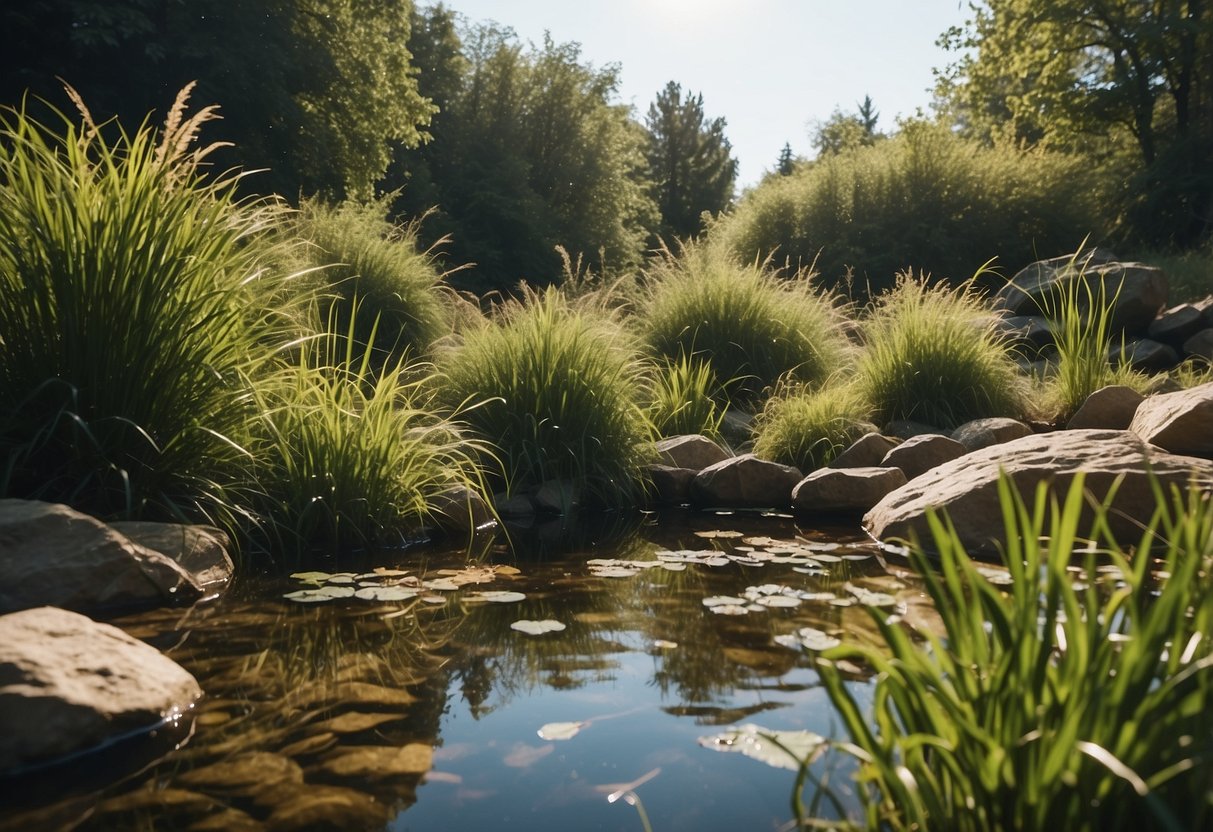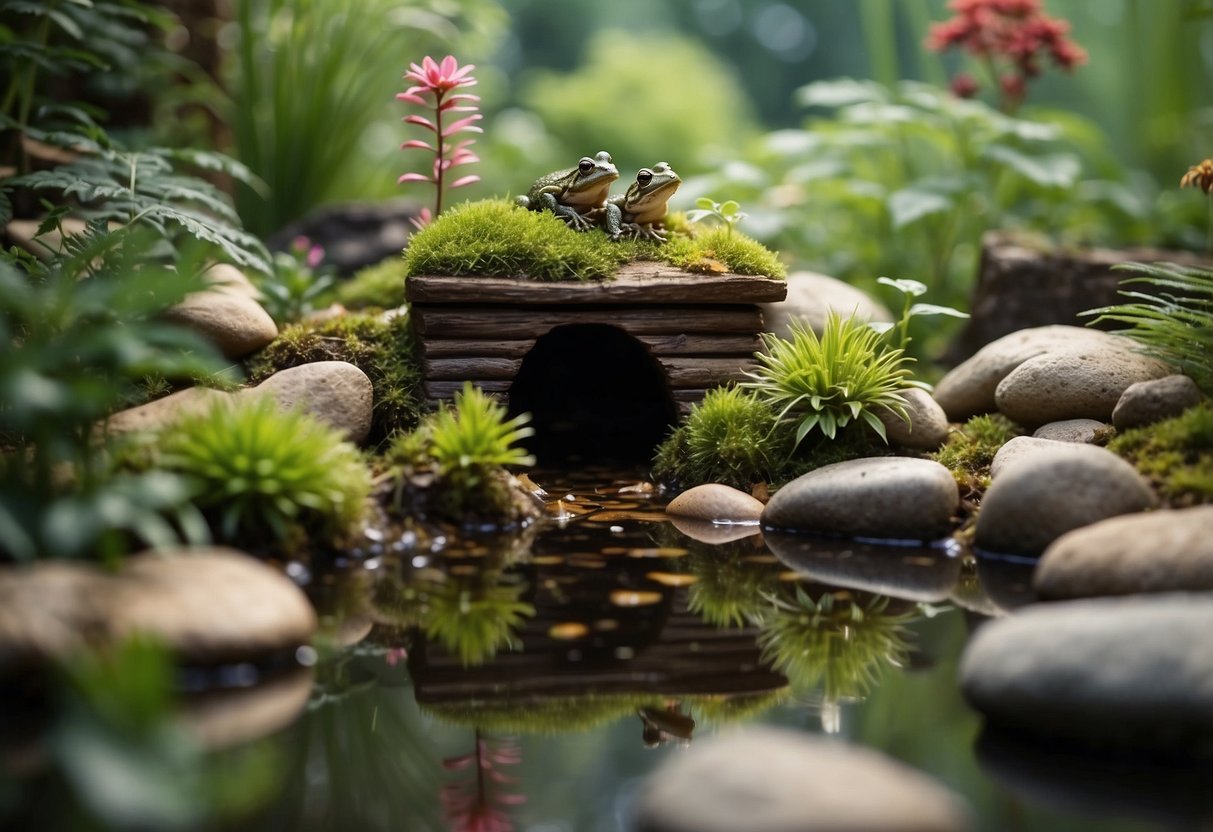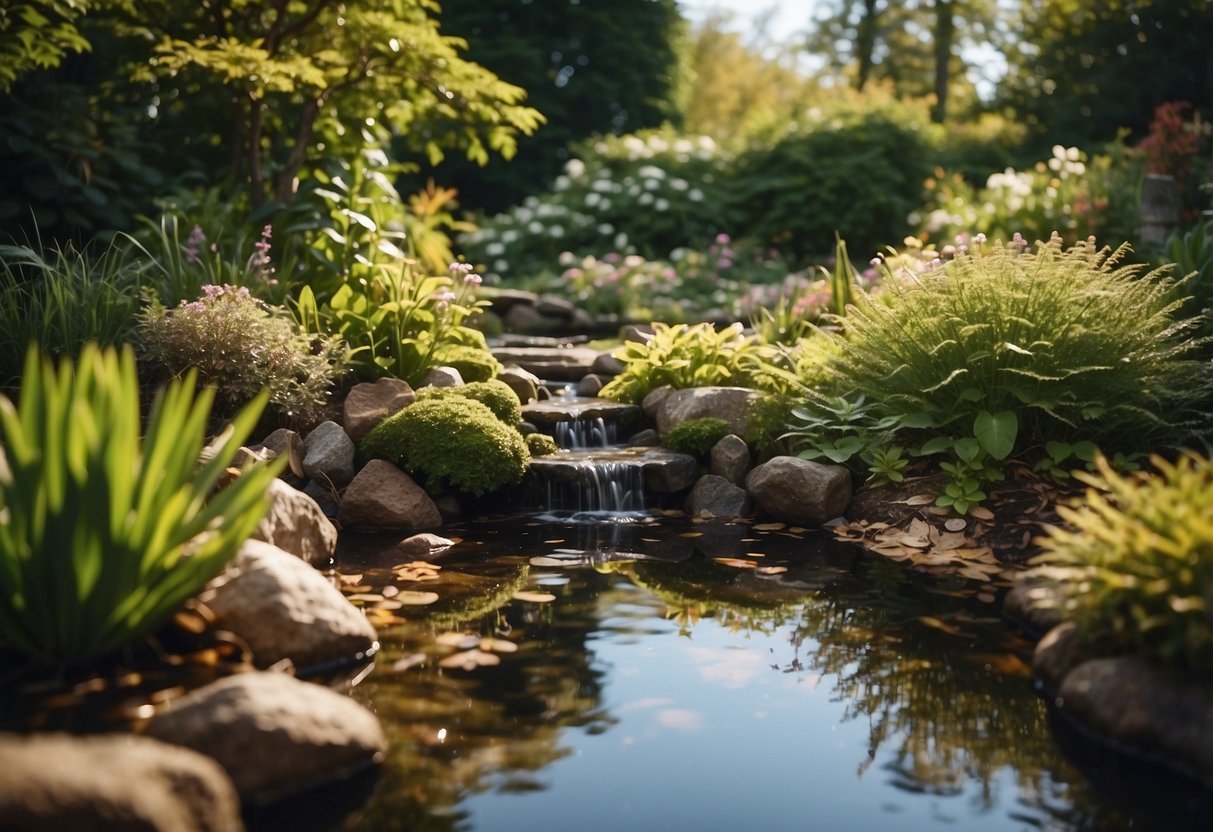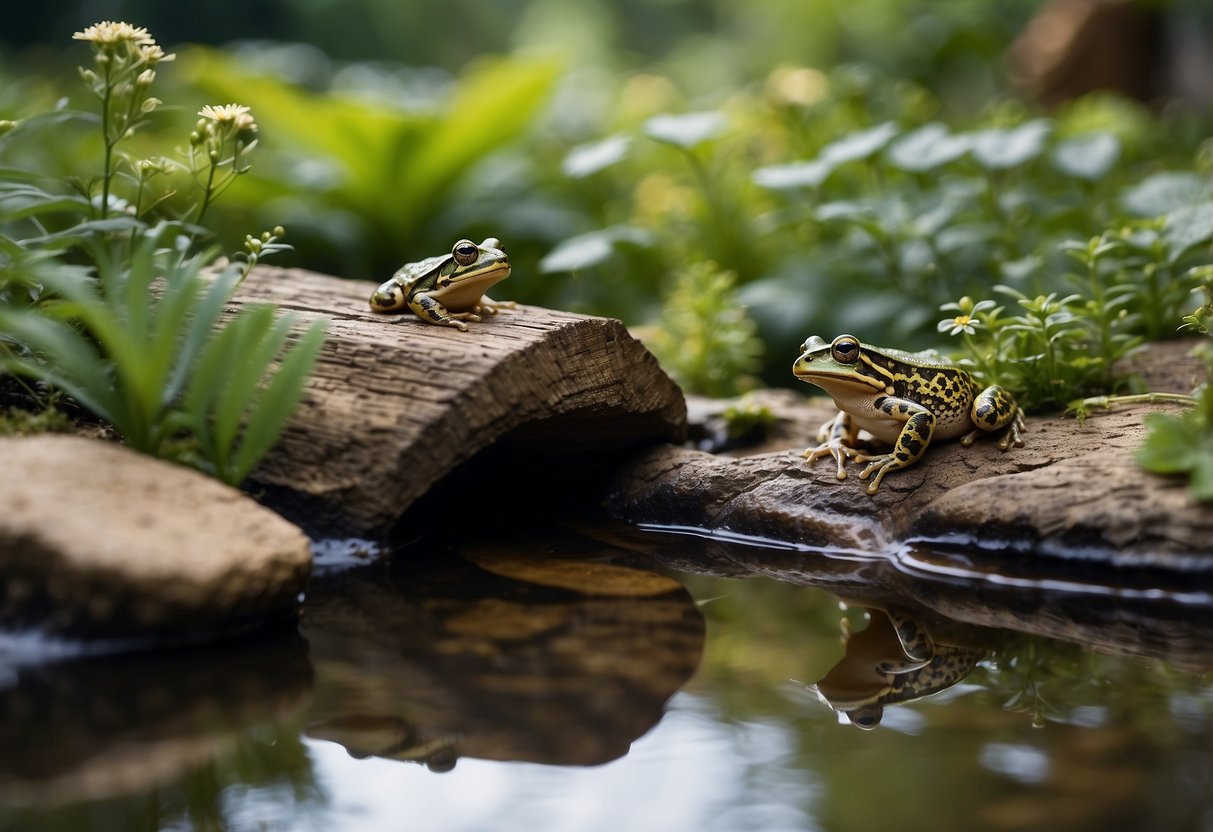How can I provide shelter for frogs and toads in my garden?
Simple DIY habitats for amphibians
Frogs and toads can be great helpers in a garden. They eat bugs and make nice sounds at night.
I’ve learned some easy ways to give them places to live in my yard.

To provide shelter for frogs and toads in your garden, you can create small ponds, leave areas of tall grass, and make simple hiding spots with rocks or logs. These little creatures need safe places to rest and stay cool during the day.
I like to leave an area near my pond un-mowed. This gives frogs and toads cover from animals that might try to eat them. It also brings in more bugs for them to munch on.
Even a small water feature like a dish filled with water can help attract these helpful garden friends.
Key Takeaways
- Frogs and toads need water, shelter, and food to thrive in gardens
- Simple changes like adding a small pond or leaving grass unmowed can attract amphibians
- Creating frog-friendly spaces helps control pests and adds natural sounds to your yard
Understanding Frogs and Toads
Frogs and toads are amazing creatures that can benefit our gardens. They have specific habitat needs and face various threats in the wild. Let’s explore what these amphibians prefer and the challenges they encounter.
Habitat Preferences
Frogs and toads like moist, shady areas with plenty of hiding spots. I’ve found that they enjoy small ponds or water features for breeding and staying hydrated.
In my garden, I make sure to provide:
- Dense vegetation near water sources
- Piles of rocks or logs for shelter
- Leaf litter and mulch for ground cover
These elements mimic their natural habitats. I also avoid using chemicals in my garden, as amphibians have sensitive skin that can absorb toxins easily.
Threats to Amphibians
Frogs and toads face many dangers in our modern world. I’ve learned that habitat loss is a major issue. As we build more houses and roads, we destroy their homes.
Other threats include:
- Pollution of water sources
- Climate change affecting breeding patterns
- Predators like birds, snakes, and domestic pets
To help, I create shelters in my garden using overturned flower pots or purpose-built toad houses. This gives them safe spaces to hide from predators and harsh weather.
I also maintain a chemical-free garden to protect their delicate skin and ecosystems.
Designing a Garden for Amphibians
Creating a frog-friendly garden involves specific landscape features, water sources, and plant choices. These elements work together to provide a safe and inviting habitat for amphibians.
Landscape Features
To make my garden appealing to frogs and toads, I focus on creating diverse terrain. I add log and rock piles to provide shelter and hiding spots. These structures protect amphibians from predators and harsh weather.
I leave some areas of my garden unmowed and free from chemicals. This creates a natural environment where frogs can thrive. Long grass offers cover and attracts insects for food.
I also include small tunnels and cavities by stacking branches. These spaces give frogs places to rest and hibernate.
Water Sources
A water source is vital for attracting frogs to my garden. I dig a shallow pit and line it with a waterproof material to create a small pond. The edges are gently sloped for easy access.
I add some aquatic plants to provide cover and keep the water clean. Floating plants like duckweed offer shade and hiding spots.
I make sure the water is slightly murky. Clear water can make frogs easy targets for predators. I also avoid using chlorinated water, as it can harm amphibians.
Plant Choices
I select native plants that suit my local climate and soil. These plants attract insects, a key food source for frogs.
I include a mix of ground cover, shrubs, and trees. This variety creates different layers in my garden, mimicking a natural habitat.
Some frog-friendly plants I use are:
- Ferns
- Mosses
- Native grasses
- Wetland plants like rushes and sedges
I avoid using pesticides on these plants. Chemicals can harm frogs and reduce their food supply.
Creating Shelters
Frogs and toads need safe places to rest and hide in gardens. I’ll cover natural and artificial shelter options, plus how to maintain them.
Natural Shelters
I recommend using plants and logs to make natural frog shelters. Thick ground cover like ferns or hostas gives frogs cool, damp spots to rest. I pile up fallen leaves and branches in quiet corners of my garden. This mimics their forest homes.
Large flat rocks work great too. I place them near water sources, leaving gaps underneath for frogs to squeeze into. Native plants are ideal – they attract insects frogs eat.
For toads, I create small burrows. I dig shallow holes and cover them with bark or wood. Toads love these dark, moist hideaways during hot days.
Artificial Shelters
I make simple toad abodes using clay flowerpots. I turn the pot upside down and prop up one side with a small rock. This lets frogs hop in and out easily.
Old pipes or ceramic tubes work well too. I partially bury them in the ground, leaving openings at both ends. Broken terracotta pots make great shelters. I stack pieces to form small caves.
For a fun project, I build mini “frog hotels” using stacked rocks or bricks with gaps between them. I make sure to use non-toxic materials that won’t harm the amphibians.
Maintenance of Shelters
I check my frog shelters regularly to keep them safe and comfy. In spring, I clear out any debris that gathered over winter. I make sure entrances aren’t blocked.
During dry spells, I mist natural shelters to keep them damp. For artificial ones, I place them in shady spots to prevent overheating. I avoid using chemicals near shelters.
In fall, I add extra leaves around shelters for winter insulation. I also make sure shelters have proper drainage to prevent flooding.
Seasonal Considerations

Frogs and toads have different shelter needs throughout the year. I’ll explain how to provide suitable habitats during breeding season and hibernation.
Breeding Season
During spring and early summer, frogs and toads seek out water for breeding. I recommend creating a small pond or water feature in my garden. It doesn’t need to be big – even a shallow dish filled with water can work.
I make sure to include some aquatic plants and rocks for egg-laying. Around the water’s edge, I plant dense vegetation to give the amphibians cover from predators.
For toads, I create shallow depressions in damp soil near the water. They prefer these for breeding over deeper ponds.
Hibernation
As temperatures drop, frogs and toads look for safe places to hibernate. I prepare winter shelters in advance.
In my garden, I create piles of leaves, logs, and rocks in protected areas. These mimic natural hibernation spots. I make sure these piles are in spots that won’t flood.
For pond-dwelling frogs, I ensure my pond has deep areas that won’t freeze solid. I also avoid clearing all vegetation around the pond, as some frogs hibernate in mud under plants.
I create “toad houses” using overturned ceramic pots with entrance holes. I place these in shady, damp areas of my garden.
Amphibian-Friendly Practices
I can make my garden a safe haven for frogs and toads by avoiding harmful chemicals and managing the space thoughtfully. These practices will create a welcoming habitat for amphibians to thrive.
Pesticides and Chemicals
I need to be careful with the products I use in my garden. Chemical pesticides can harm amphibians, so I’ll avoid them completely.
Instead, I’ll opt for natural pest control methods like companion planting or handpicking pests.
I’ll also be mindful of fertilizers. Organic options are best for amphibian health. If I must use chemical fertilizers, I’ll apply them sparingly and keep them away from water sources.
When cleaning garden tools or surfaces, I’ll use eco-friendly soaps. Harsh chemicals can seep into the soil and harm frogs and toads.
Garden Management
I’ll leave some areas of my garden a bit wild. Tall grasses and leaf litter provide shelter for amphibians. I’ll also create brush piles or log stacks as hiding spots.
Mowing less often helps protect frogs and toads. When I do mow, I’ll check for amphibians first and set the blade higher.
I’ll add a shallow water feature like a small pond or even a terra-cotta saucer filled with water. This gives amphibians a place to cool off and lay eggs.
Native plants are crucial for attracting insects that frogs and toads eat. I’ll include a variety of ground covers, shrubs, and trees in my garden.
Community Engagement

Getting others involved can boost frog and toad populations in your area. Working together makes a bigger impact and spreads awareness about these helpful amphibians.
Educating Neighbors
I find that talking to my neighbors about frogs and toads is a great start. I share how these creatures help control pests naturally. I also explain that fewer pesticides mean more frogs.
I organize a neighborhood meeting to discuss frog-friendly gardening. We talk about creating water features and shelters. I bring examples of simple toad abodes to show how easy it is.
I also set up a booth at local events. Here, I hand out flyers on frog conservation. Kids love the frog-themed activities I provide. This helps spark interest in amphibian protection.
Volunteer and Conservation Projects
I join local conservation groups focused on amphibians. We work on projects like cleaning up ponds and streams, which improves frog habitats in our community.
I help organize a community “frog night.” We gather to listen for frog calls and learn to identify species. It’s fun and educational for all ages.
I volunteer at schools to teach kids about frogs. We build small frog habitats in the schoolyard, and this hands-on approach gets students excited about conservation.
Lastly, I participate in citizen science projects. I report frog sightings to help researchers track populations. This data is crucial for protecting these important animals.
Monitoring and Adjusting

Keeping an eye on your frog and toad habitat is key. I’ll show you how to check if it’s working and make it even better.
Assessing Habitat Success
I like to look for signs that frogs and toads are using my garden. I listen for croaking sounds, especially at night or after rain. Spotting egg masses in water features is a good sign too.
I check for tadpoles in spring and early summer. Seeing adult frogs or toads is the best proof my habitat is working. I count how many I see over time to track changes.
I also look for indirect signs. Fewer garden pests can mean frogs and toads are eating them. I take photos to compare my habitat’s growth year to year.
Making Improvements
If I don’t see many frogs or toads, I make changes. I might add more water features like shallow dishes or small ponds. Adding native plants near water gives them cover.
I create more hiding spots with toad abodes, which can be simple clay pots or log piles. I also make sure there are damp, shady areas in my garden.
I stop using chemicals in my yard to keep the habitat safe for amphibians. I might add a small light to attract insects for food. If water dries up too fast, I add more or deepen existing features.
Frequently Asked Questions
People often want to know how to create frog-friendly gardens. I’ll address common questions about attracting amphibians, building habitats, and providing safe environments.
What can I do to attract frogs and toads to my garden?
To attract frogs and toads, I recommend adding a water feature to your garden. This can be as simple as a terra-cotta saucer filled with water.
I also suggest creating damp, shady areas with lots of plants. Frogs and toads love to hide in dense vegetation.
How do I build a habitat for frogs in my backyard?
Building a frog habitat is easy. I recommend starting with a shallow pond or water feature.
Next, I’d surround it with native plants and add some logs or rocks for hiding spots. Frogs need places to escape predators and the sun.
Is it beneficial to have frogs and toads in my garden?
Yes, frogs and toads are very beneficial. They eat insects, including pests that can damage plants.
I find that gardens are important habitats for amphibians, especially in urban areas. By welcoming them, you’re helping local wildlife.
What materials are needed to create a DIY frog house?
For a DIY frog house, I suggest using simple materials. Terracotta pots or bricks work well.
I’d stack these to create small cavities. Remember to leave gaps for the frogs to enter and exit.
Are there any risks associated with having toads in the garden?
The risks of having toads in the garden are minimal. Some people worry about their pets, but most animals learn to leave toads alone.
I advise keeping an eye on curious pets or young children at first. Toads can secrete a mild toxin if threatened.
How can I provide a safe environment for amphibians without a pond?
Even without a pond, I can create a frog-friendly space. I’d focus on providing moist areas and hiding spots.
A shallow dish of water is a good start. Also, some large leaves for shade, and a pile of rocks or logs can make a great amphibian habitat.
